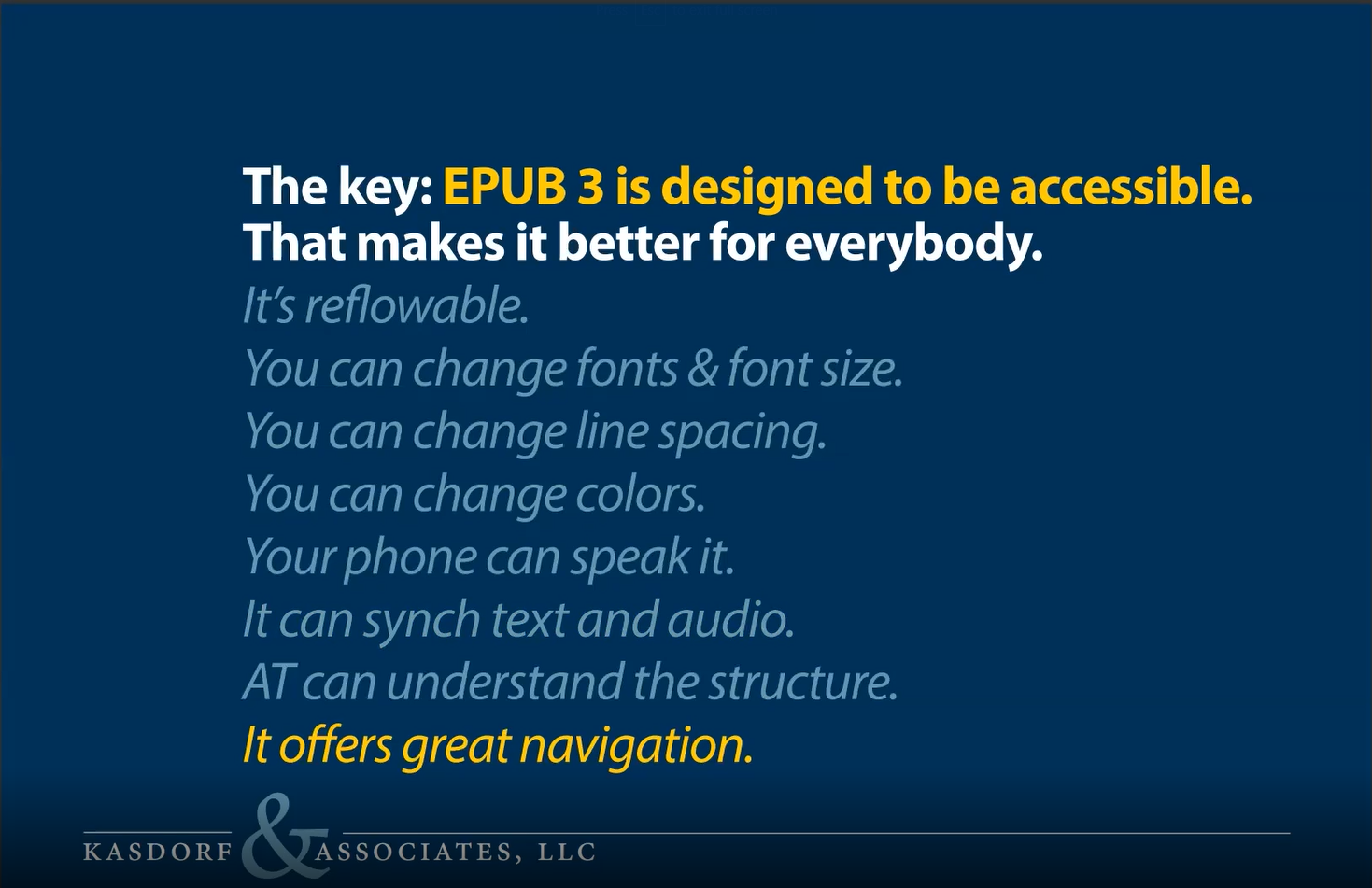MODERATOR:
Bill Kasdorf
Kasdorf & Associates, LLC
Ann Arbor, Michigan
@billkasdorf
SPEAKERS:
Bill Kasdorf
Jon McGlone
University of Michigan Press
Ann Arbor, Michigan
Caroline Desrosiers
Scribely
San Francisco, California
@scribelytribe
REPORTER:
Heather DiAngelis
Transportation Research Board at the National Academies of Sciences, Engineering, and Medicine
Washington, DC
@hdiangelis
Bill Kasdorf of Kasdorf & Associates, LLC, kicked off the session by noting that accessibility makes publications better, easier to read and navigate, and even easier to understand. “Making content and systems accessible,” he said, “is no longer considered to be a special case for a very few people.” Accessibility should be ingrained in publications from the start so publishers can maintain efficiencies in workflows and provide universal accessibility.
Kasdorf described the advantages of EPUB 3’s accessibility, including its reflowability across platforms and technologies; ability to change fonts, font sizes, and colors; and text and audio synchronization (Figure). To successfully achieve this, it is essential for heading levels and tables of contents to be correct for later EPUB tagging. Proper identification of cross-referenced links is also essential for later identification by screen readers. Kasdorf noted that another common problem with accessibility comes from tables—proper layout of tables ensures proper rendering by accessibility devices, while an improperly laid-out table can cause great confusion for readers. The editor should also assist accessibility by editing and refining the alt text image descriptions provided by the author.

Jon McGlone, Digital Product Design Engineer and Accessibility Specialist at the University of Michigan Press, spoke second. He advised that publishers should do what they can for accessibility by starting small and iterating often; this can help lead to new workflows and open doors to making content more accessible. He noted that accessibility is ongoing, and that it is most effective when built into everyday tasks. Editorial staff, McGlone said, are the “accessibility frontline”—it is up to them to promote, review materials, flag accessibility issues, and communicate to the production team. They should aim to see how visible elements (such as figures and text) work together with hidden elements (such as alt text) within the context of a product.
Image selection by an editor also provides an important role in accessibility, as editors should ask themselves whether an image is 1) essential to publication, 2) well chosen, and 3) well placed. The use of color should also be considered; while color can enhance an image, color alone should not be used to convey information. Reviewing alt text for consistency, point of view, intention, completeness and concision, and order efficiency is crucial for ensuring high quality. McGlone reminded the audience that in order to provide value, alt text should be unique for each figure and unique from the figure caption. Tables and equations also present difficulties for assistive technologies, so editors should be aware of ways to simplify them when possible, such as converting a table to an in-text list and using Unicode fonts or MathML—not images—for equations. Finally, he remarked that it is important for a publication to have a good accessibility statement that is updated regularly, identifies standards and best practices followed, and provides contact information.
The third speaker was Caroline Desrosiers, CEO and Founder of Scribely, who focused on how to make images accessible through both alt text and extended descriptions. When it comes to ensuring a high-quality digital content experience, it is essential to provide image descriptions as early as possible in the process. To implement this, a publication should have or gain 1) knowledge of Web Content Accessibility Guidelines, 2) subject and industry knowledge and expertise, 3) writing proficiency and effective communication skills, 4) the ability to make informed decisions about subjective content, and 5) the ability to put oneself in another’s shoes.
Per Desrosiers, an editor can greatly improve the quality of alt text by thinking about context and purpose, describing all relevant details, being concise, and considering whether the alt text allows readers to visualize the image on the page. To provide relevant and useful extended descriptions, the editor should review surrounding context, continue—not repeat—information provided in alt text, elaborate on context and purpose, start general before getting more specific, and once again ask whether the extended descriptions allow readers to visualize the image. Finally, alt text and extended descriptions should undergo quality assurance and user testing. Desrosiers ended by describing ways to establish a workflow, such as creating an input channel for all image assets, adding or updating International Press Telecommunications Council (IPTC) metadata properties, synergizing with other systems, and sharing and distributing assets. In conclusion, she reminded the audience that “content is not complete until it is accessible to everyone.”
The session ended with a question-and-answer period about alt text vendors, complexity and advantages of rendering equations from MathML, challenges with getting authors to write image description drafts, and key differences between figure captions and alt text.
